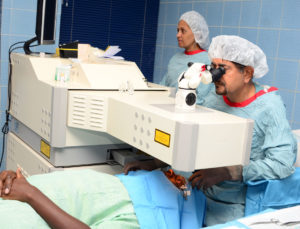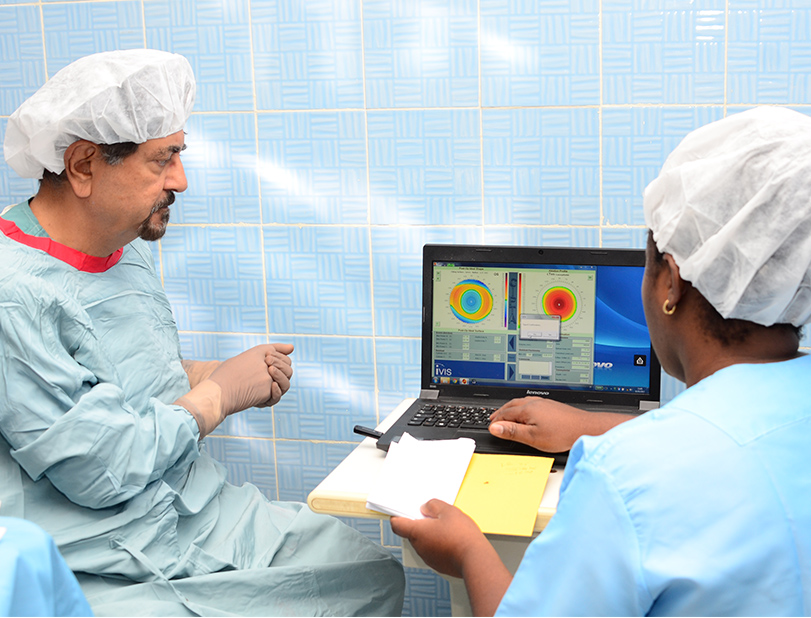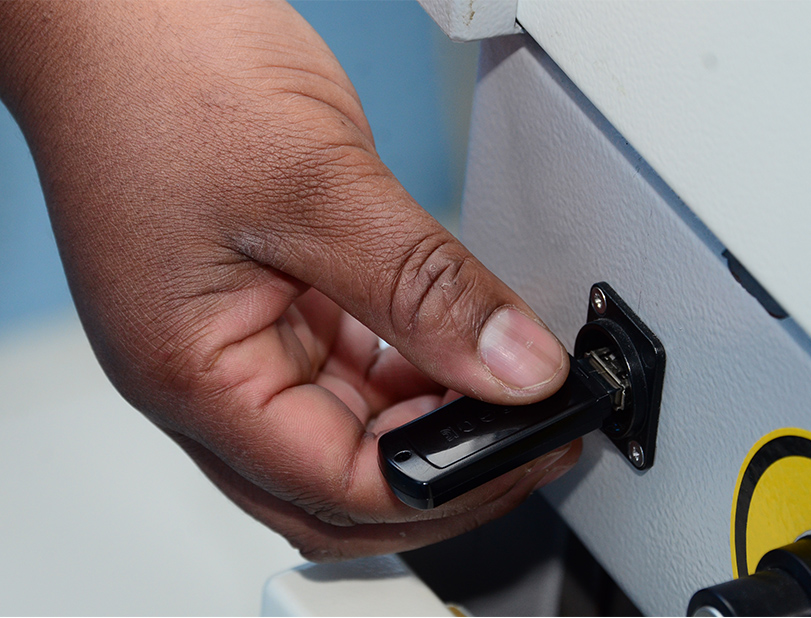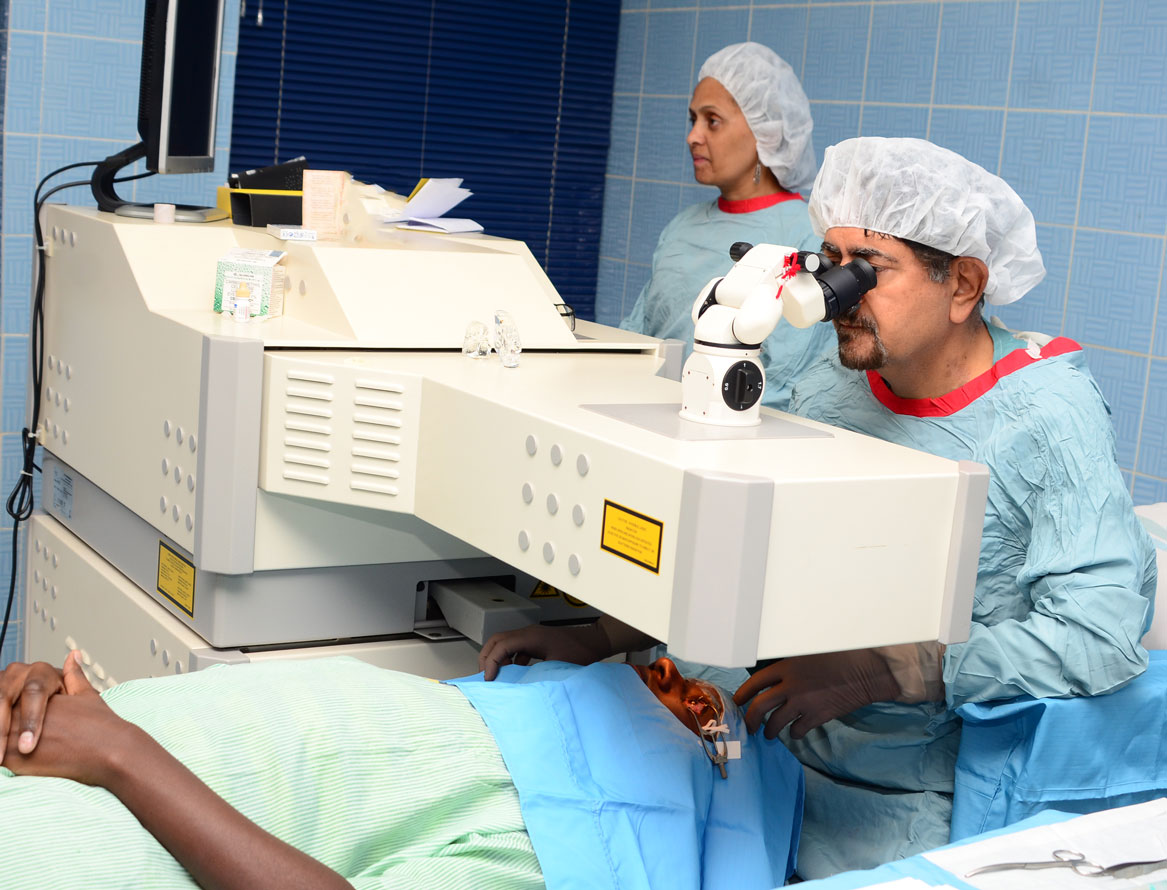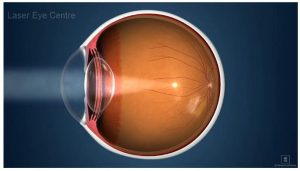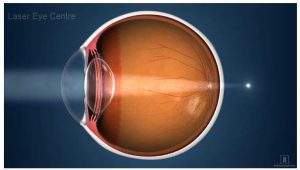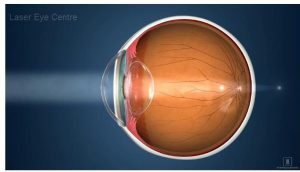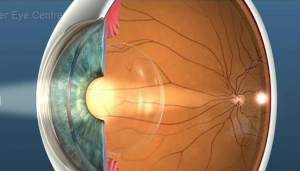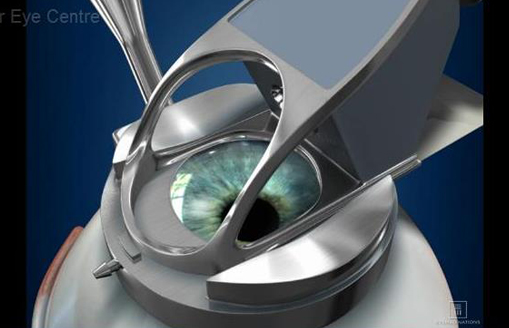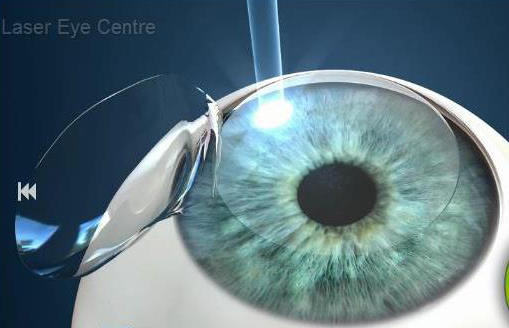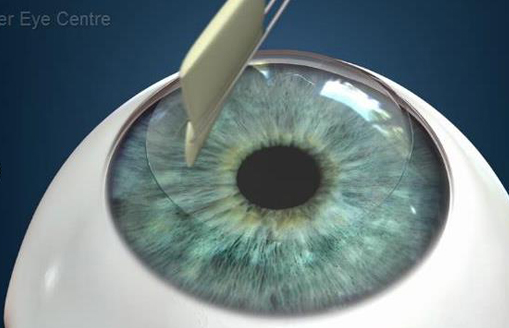C-Ten “No-Touch No-Cut” Laser Vision Correction
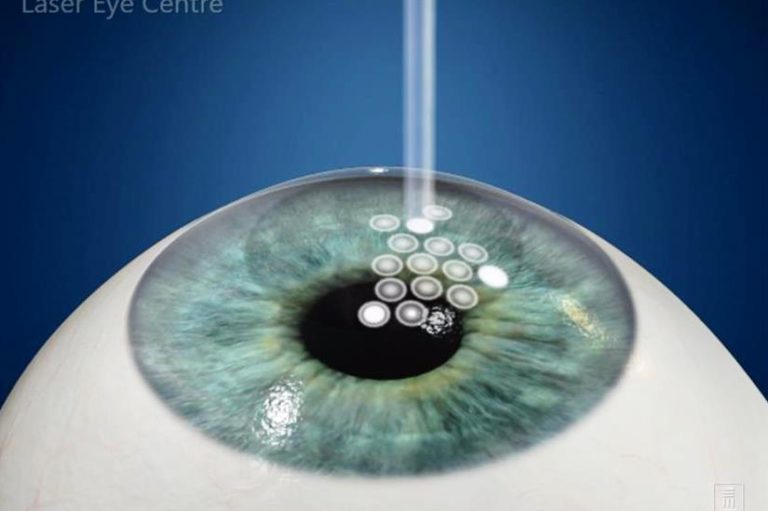
Laser Vision Correction in 30 Seconds
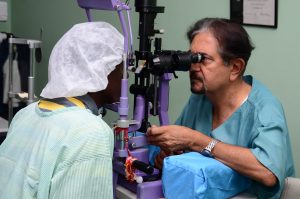
Dr. Joshi examining a patient and providing a prescription of spectacles
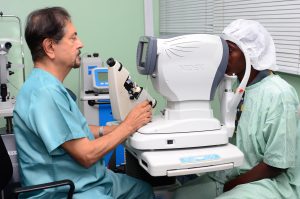
Checking the refraction of the patient
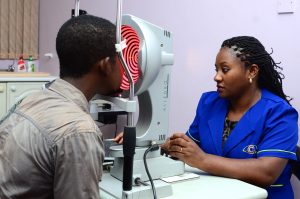
Topography takes the mapping of the cornea
- The patient’s data is exported into the iRES IVIS 1000Htz laser machine.
- Anaesthetic eye drops are placed in the patient’s eyes the patient lie back on a Laser Bed and an eyelid holder is inserted gently to prevent blinking.
- The patient looks at a blinking red light inside the laser apparatus.
- The C-TEN procedure is completed within 30 seconds.

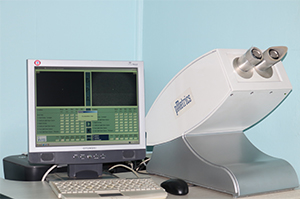

Modern Tomography Precisio provides a detailed, three dimensional mapping of corneal inner and outer surface.
Takes about 39,000 spots of the eye and defines the real shape of the cornea’s anterior and posterior surfaces, 3-D Pachymetry and anterior chamber dimensions.
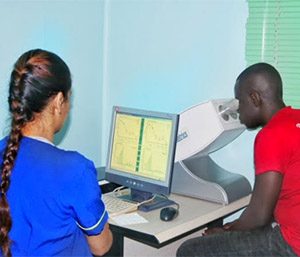
pMetrics- measuring the size of the pupil
pMetrics is used to measure the size of the pupil in different lighting conditions. In low light the pupil is larger than the strong lighting.
Since pupil size varies from person to person, it is important to determine how each pupil reacts to provide a customized procedure-metrics is measuring the size of the pupil in 6 different lighting conditions.
Laser eye surgery: New technology offers surgical solution
WHO WILL BENEFIT FROM LASER VISION CORRECTION?
MYOPIA
Myopia, more commonly known as short-sightedness, occurs when an eye has too much focusing power.
This means that the eyeball is either too long or the cornea is too steep and the projected image falls short of the retina. The result is an improperly transmitted message to the brain or simply a blurred image.
HYPEROPIA
Hyperopia or long-sightedness occurs when an eyeball is too short or the cornea’s curvature is too flat.
Therefore, the image that is being focused upon falls past the retina resulting in blurred or distorted vision.
.
ASTIGMATISM
An astigmatic eye has an uneven surface — the cornea can be more curved or steeper at one axis than others.
This results in having more than one focal point and of course blurred vision. An astigmatic eye is shaped more like a football (toric) whereas a normal shaped eye is more spherical, like a basketball.
PRESBYOPIA
Presbyopia is a natural ageing process whereby we have difficulty in near work like reading and writing. Usually it sets in from the age of 40.
The lens of the eye hardens and the muscles weaken. When people who have perfect vision all their lives become Presbyopic, they need to wear reading glasses. People who already wear glasses for distance vision need to wear bifocals.
AFTER CATARACT SURGERY
There are still some traditional big incision cataract surgeries being done in East Africa, which lead to high astigmatism and in some cases, there could be an error in the calculation of the intraocular implant. Therefore, after the cataract operation, patients need to wear glasses which can easily be rectified by C-TEN laser vision correction.
AFTER CORNEAL TRANSPLANT
Sometimes after successful corneal transplants, recovery of the vision is not good because of high astigmatism caused by irregular surface of the cornea. Now with C-TEN laser vision correction, we can improve the quality of vision for such patients in 30 seconds.
LASIK
LASIK COMPLICATIONS:
- Flap is made- which means there will be surgical instruments touching the patient’s eyes.
- Since the flap is lifted for the laser vision correction, there are chances of flap related complications.
- In some patients, after the flap is re-positioned, there could be some inflammation under the flap which can make vision very cloudy.
- Sometimes, surface cells (epithelium) can go under the flap.
- Possibility of dry eyes, as when the cornea is cut, the corneal nerves are cut which can lead to dry eyes for a few years, and permanently for some patients.
- The LASIK corneal flap can lead to night driving difficulty.
- While cutting the corneal flap, the corneal criss-cross architecture is damaged, which can make the cornea weak. In some patients, the cornea can start bulging, known as ectasia.
- Since there would be pressure on the cornea to raise the flap, biomechanical strength is compromised by 40%.
C-TEN VS LASIK
It is clear how the C-TEN treatment is more advanced, faster, and safer with zero contact with the patient’s eye.
C-TEN
LASIK
THE DIFFERENCES AT A GLANCE
| C-TEN (NO-TOUCH NO-CUT LASER) – (RECOMMENDED) | LASIK (NOT RECOMMENDED) |
|---|---|
| NO FLAP CREATION | FLAP CREATION |
| NO FLAP RELATED COMPLICATIONS AS FLAP IS NOT MADE | POSSIBILITY OF FLAP RELATED COMPLICATIONS |
| LESS INTERFACE COMPLICATIONS | INTERPHASE COMPLICATIONS SUCH AS DLK OR EPITHELIAL GROWTH MAY OCCUR |
| LESS INTERFACE COMPLICATIONS | DRY EYES |
| LESS CHANCES OF OPTICAL COMPLICATIONS | OPTICAL COMPLICATIONS SUCH AS SPHERICAL ABBRETIONS WHICH LEAD TO NIGHT DRIVING PROBLEMS |
| LESS CHANCES OF OPTICAL COMPLICATIONS | BIOMECHANICAL STRENGTH IS COMPROMISED BY 40% |
Laser light is low-energy coherent light of a single wavelength whose energy is concentrated and works together in one direction. It can be focused to a point and be used surgically to treat eye problems.
Lasers work with the heat generated from light, or with many tiny energy pulses. Because laser light can be controlled so precisely, it is safe and reliable.
No, but about 95 per cent of glasses and contact lens users are.
If you suffer from an existing corneal or retinal disease, Type 1 Diabetes, inflammation in the eye or Aids, an extremely thin cornea or Keratoconus, it will not be possible to perform this procedure.
On the day of the procedure, the patient is told to lie under the machine. After inserting an anesthetic drop into the eye, a small clip is put in place to prevent blinking.
The patient is asked to look at a red fixation light. The surgeon activates the machine, and the procedure is done within 30 seconds.
- C-Ten is a non-contact laser – This the first laser whereby the surgeon does not touch the eyes of the patient.
- C-Ten is performed with the fastest laser in the world therefore there is a shorter period in the healing process.
- C-Ten Laser is tailored to each patient’s eye and thus provides a fully customised laser vision correction procedure.
Assessment
It is very important for you to come in for an assessment, as not everyone who wears glasses or contact lenses is a suitable candidate for Laser Vision Correction. The consultation would take between 45 min to 1 hour.
Note: Patients with soft contact lenses should not wear them for one week before the assessment and those with hard contact lenses should not wear them for 48 hours prior to consultation.
There are other options if you do not qualify for Laser Vision Correction. These are Reflex surgery or Phakic IOL insertion.
Reflex surgery

IOL Master Examination
Some patients have the option of undergoing refractive lens exchange, otherwise known as the Reflex Surgery instead of Laser Vision Correction. The normal lens inside the eye is dissolved, leaving an empty bag by a method known as Phacoemulsification whereby a high vibrating ultrasonic needle (which is attached to the Phaco machine) dissolves the lens matter and sucks it out. The existing lens is then replaced by an Intra Ocular Implant, which replaces the previous spectacle prescription. In some patients, there is a choice of implanting a multi-focal lens so that they can focus far and near at the same time.
In order to calculate the exact power of the lens to be implanted, Laser Eye Centre has installed the first IOL Master in East and Central Africa. The IOL Master calculates the precise power of the lens to be implanted. Laser Eye Centre is the first Centre offering such multi-focal implants.
Who will benefit from reflex surgery?
- High hypermetropic patients above +5 to +6 who are unsuitable to undergo Laser Vision correction.
- Patients who are above the age of 45 and who have Hypermetropia: If Laser Correction is done on such a patient, they will attain good distant vision however, the patient will still have to wear glasses for near vision. In Reflex Surgery the multi-focal lens implant will eliminate or reduce the dependency on glasses for distant or near vision.
- Patients above 55 who have got early Cataract like symptoms: it will be advisable for them to undergo the Reflex Surgery, rather than Laser Correction because these patients will require Cataract Surgery in the future. Therefore, lens surgery would be a better option which eliminates the need of Cataract Surgery in the future as well.
Please note: High Myopic patients are unsuitable for Reflex Surgery
Phakic IOL
Phakic IOL is a solution where corneal Refractive Surgery is not possible. They address refractive errors using a Phakic Intra-ocular lens. These lens implants are designed to be inserted within the eye and hidden. They are either attached to the iris (anterior) or hidden between the iris and the eye’s natural lens (posterior). Once in place, Phakic IOLs work together with the eye’s natural focusing system to deliver clearer vision. They can correct a wide range of refractive errors and strong errors. A Phakic IOL implant can be left in permanently but if the need or desire arises, these lenses can be removed or updated to meet potential changes in your vision needs.
Doctors achieve perfect vision correction in 99.7 per cent of patients, which means that only three people out of every 1,000 will require a touch-up in the future.
Yes, it can be done.

